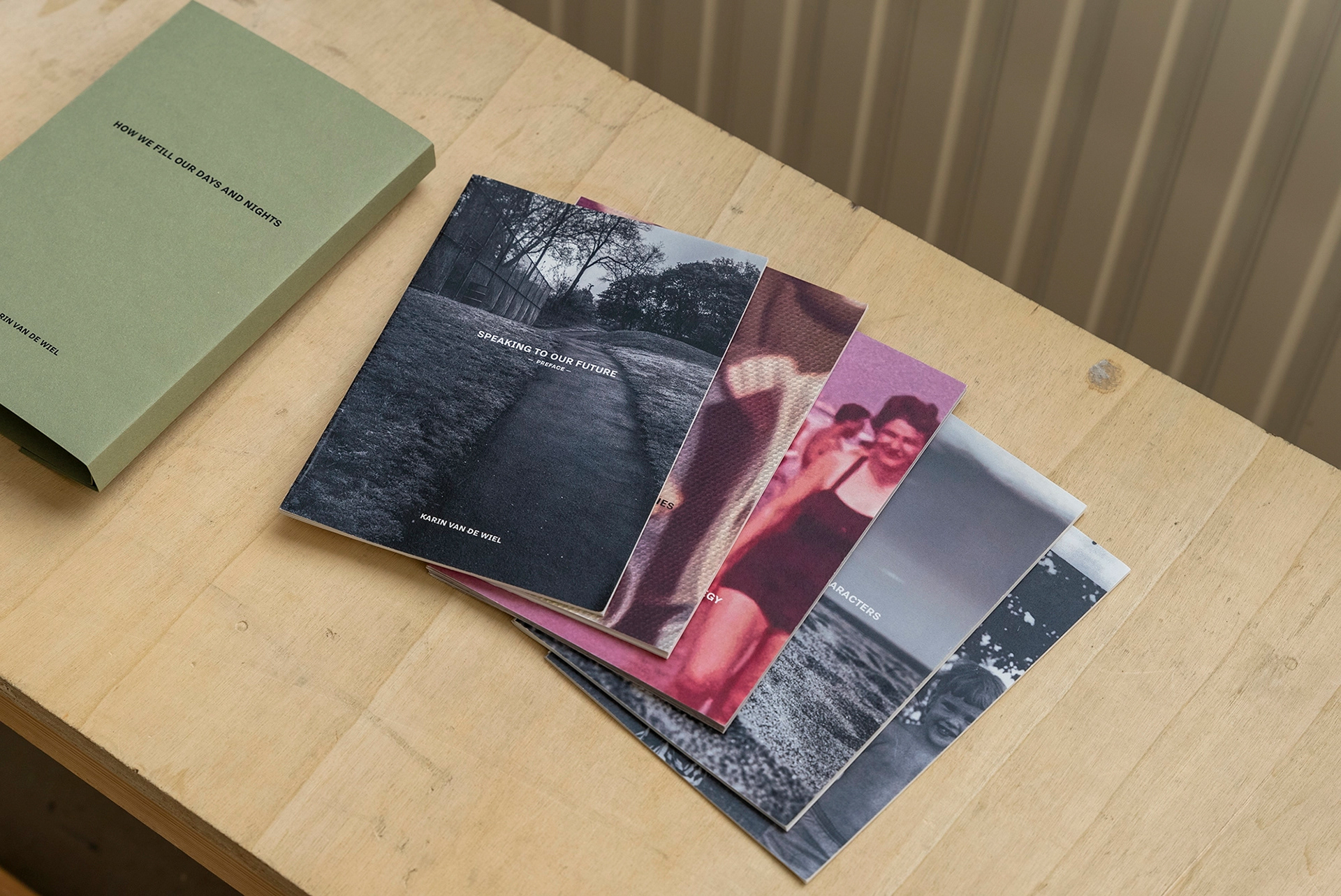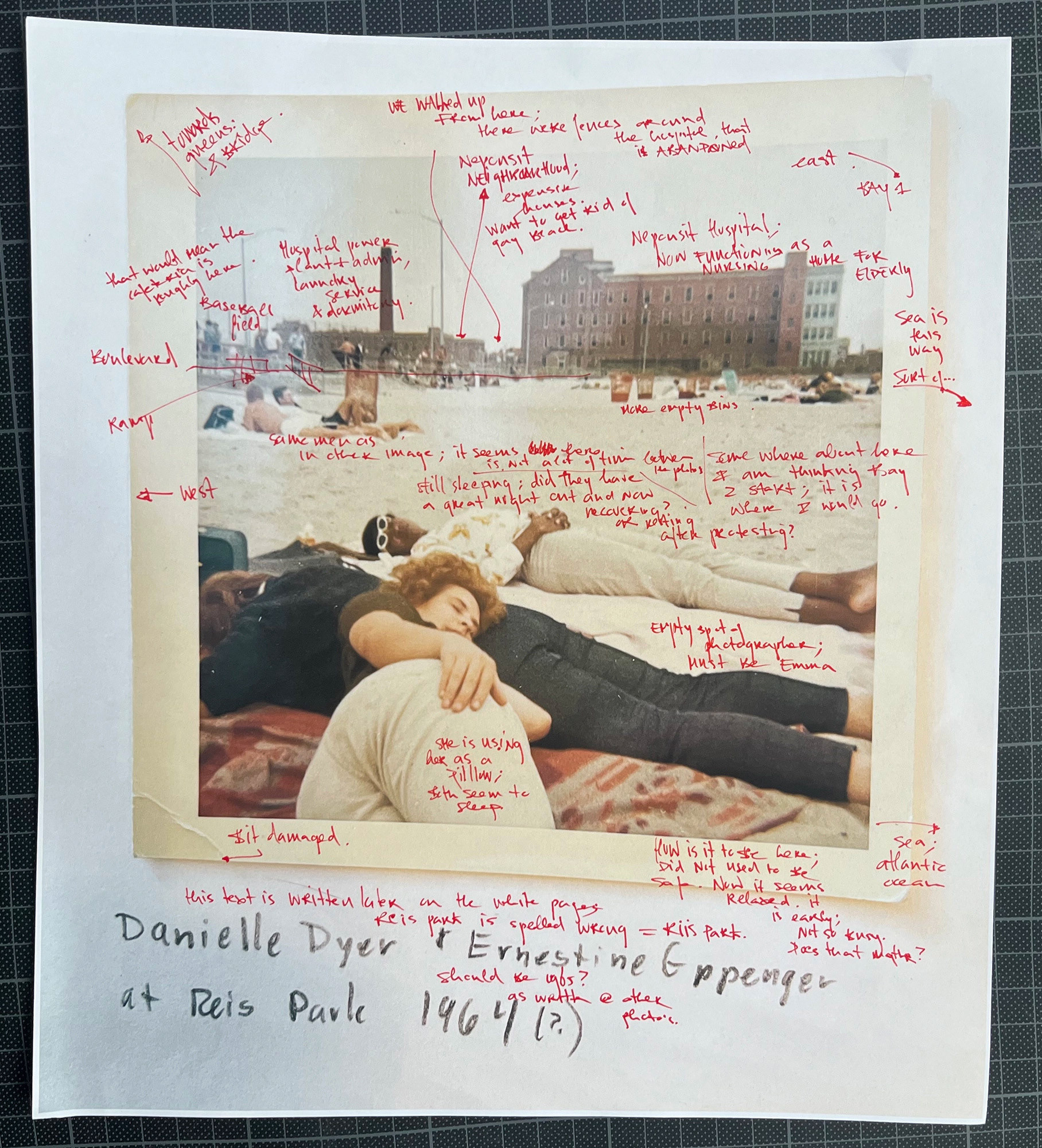The women’s movement understood the need for a profound breaking of boundaries when it embraced the slogan ‘the personal is political.’ I would like to carry it one step further: if the personal is political, the more personal is historical.
The more personal demands attention be paid to how we fill our days and nights as we participate in any given economic system, how our flesh survives under different political systems, how we humanise gender tyranny, how we experience womanness and maleness in all the superstructures of class and race.
– Joan Nestle, founder of the Lesbian Herstory Archives, A Restricted Country (1987)



On whose shoulders do I stand?
In april 2023 verblijf ik een maand in New York om te werken aan mijn onderzoek naar de relatie tussen ruimte, identiteit en macht. Ik keer terug naar plekken die ik eerder fotografeerde en verken nieuwe locaties die een rol spelen in mijn onderzoek naar hoe ruimte een politieke lading heeft. Een belangrijk onderdeel van dit verblijf zijn mijn bezoeken aan het Lesbian Herstory Archives.
In april 2023 verblijf ik een maand in New York om te werken aan mijn onderzoek naar de relatie tussen ruimte, identiteit en macht. Ik keer terug naar plekken die ik eerder fotografeerde en verken nieuwe locaties die een rol spelen in mijn onderzoek naar hoe ruimte een politieke lading heeft. Een belangrijk onderdeel van dit verblijf zijn mijn bezoeken aan het Lesbian Herstory Archives.
In de loop der jaren ben ik veel foto’s tegengekomen van lesbische vrouwen, vooral in de context van protesten of bijeenkomsten. Maar ik wil weten: wat heb ik nog niet eerder gezien? Wat speelt zich af buiten het activistische moment — in het alledaagse, het persoonlijke? On whose shoulders do I stand?
Ik werk met zeldzame snapshots van lesbische vrouwen uit de jaren 1940–1960. Deze alledaagse beelden, afkomstig uit privéalbums, tonen hoe vrouwen hun dagelijkse leven doorbrachten in publieke ruimte doorbrachten en deze plekken (her)claimden als politieke arena.
Speculatieve, subjectieve methode
In dit project verbind ik archiefmateriaal met mijn eigen ervaringen, en plaats ik het in een bredere historische en sociaal-politieke context. Ik zie de grenzen van journalistieke objectiviteit; hoe doe je recht aan queer verhalen zonder ze te reduceren tot ‘feiten’? Gaanderweg ontwikkel ik een speculatieve, subjectieve werkwijze, waarin verbeelding een rol speelt, zonder de werkelijkheid te vervormen. Deze methode laat zien hoe plaatsgebonden queer identiteiten en zogenaamde safe spaces onder druk staan — politiek, economisch, ruimtelijk — en hoe ze via geleefde ervaring en zorgvuldig onderzoek opnieuw zichtbaar kunnen worden gemaakt. Fotografie en life writing vormen hierin de kern.
In dit project verbind ik archiefmateriaal met mijn eigen ervaringen, en plaats ik het in een bredere historische en sociaal-politieke context. Ik zie de grenzen van journalistieke objectiviteit; hoe doe je recht aan queer verhalen zonder ze te reduceren tot ‘feiten’? Gaanderweg ontwikkel ik een speculatieve, subjectieve werkwijze, waarin verbeelding een rol speelt, zonder de werkelijkheid te vervormen. Deze methode laat zien hoe plaatsgebonden queer identiteiten en zogenaamde safe spaces onder druk staan — politiek, economisch, ruimtelijk — en hoe ze via geleefde ervaring en zorgvuldig onderzoek opnieuw zichtbaar kunnen worden gemaakt. Fotografie en life writing vormen hierin de kern.
Publicatie
De publicatie is opgebouwd uit een voorwoord, drie essays en een epiloog, waarin mijn proces van onderzoek, reflectie en positionering zichtbaar wordt. De essays kunnen afzonderlijk gelezen worden en lenen zich ook voor distributie via verschillende platforms en richting diverse doelgroepen.
Elk essay heeft een eigen perspectief en invalshoek op het overkoepelde thema, variërend van archiefbenaderingen tot queer zichtbaarheid en geleefde ruimte. Maar samen vormen ze een gelaagd geheel. Zo ontstaat een flexibel inzetbare publicatie die zowel inhoudelijke diepgang biedt als toegankelijk is voor bredere publiekswerking.
De publicatie is opgebouwd uit een voorwoord, drie essays en een epiloog, waarin mijn proces van onderzoek, reflectie en positionering zichtbaar wordt. De essays kunnen afzonderlijk gelezen worden en lenen zich ook voor distributie via verschillende platforms en richting diverse doelgroepen.
Elk essay heeft een eigen perspectief en invalshoek op het overkoepelde thema, variërend van archiefbenaderingen tot queer zichtbaarheid en geleefde ruimte. Maar samen vormen ze een gelaagd geheel. Zo ontstaat een flexibel inzetbare publicatie die zowel inhoudelijke diepgang biedt als toegankelijk is voor bredere publiekswerking.
OVERVIEW
Preface — Speaking To Our Future
The preface autobiographically situates the subject, includes the acknowledgments, and outlines the structure of the complete work, How We Live Our Days and Nights.
The preface autobiographically situates the subject, includes the acknowledgments, and outlines the structure of the complete work, How We Live Our Days and Nights.
Addresses Are Characters
This essay is an exploration of spaces, primarily focusing on New York landmarks. It combines personal experiences, historical narratives, and socio-political perspectives.
Starting with Jacob Riis Park, significant to the lesbian community, it depicts the park’s evolution from a safe haven for marginalised queer communities to its imminent erasure. This extends into the vanishing landscape of lesbian bars, emphasising their role beyond social hubs and highlighting the broader struggle for community and identity preservation in an ever-changing, inherently political landscape.
This essay is an exploration of spaces, primarily focusing on New York landmarks. It combines personal experiences, historical narratives, and socio-political perspectives.
Starting with Jacob Riis Park, significant to the lesbian community, it depicts the park’s evolution from a safe haven for marginalised queer communities to its imminent erasure. This extends into the vanishing landscape of lesbian bars, emphasising their role beyond social hubs and highlighting the broader struggle for community and identity preservation in an ever-changing, inherently political landscape.
A Revolution Has Many Lanes
The central focus of this essay lies on the significance of vernacular photographs housed in the Lesbian Herstory Archives. These seemingly ordinary snapshots from everyday life serve as invaluable records of the lived experiences of lesbian women. I touch upon the complexities of representation, acknowledging that identities extend beyond sexual orientation, and I consider the ethical dilemmas associated with handling these personal documents.
The central focus of this essay lies on the significance of vernacular photographs housed in the Lesbian Herstory Archives. These seemingly ordinary snapshots from everyday life serve as invaluable records of the lived experiences of lesbian women. I touch upon the complexities of representation, acknowledging that identities extend beyond sexual orientation, and I consider the ethical dilemmas associated with handling these personal documents.
Subjectivity As A Strategy
The essay explores subjectivity as a tool for reclaiming identity and visibility within the context of lesbian movement. It highlights efforts to fill historical voids with alternative narratives, referring to works by photographer JEB and activist Karla Jay.
I am welcoming the infusion of imagination and subjectivity into my thoughts and texts. I am exploring how incorporating subjectivity into my research methodology can help uncover untold stories in dynamic and inherently political spaces.
As a case study, I examine two sets of vernacular images retrieved from the Archives collection, specifically captured on Riis Park Beach in New York City during the 1960s. Through these images, I look into the historical layers, cultural narratives, societal reflections, and political dimensions they embody.
The essay explores subjectivity as a tool for reclaiming identity and visibility within the context of lesbian movement. It highlights efforts to fill historical voids with alternative narratives, referring to works by photographer JEB and activist Karla Jay.
I am welcoming the infusion of imagination and subjectivity into my thoughts and texts. I am exploring how incorporating subjectivity into my research methodology can help uncover untold stories in dynamic and inherently political spaces.
As a case study, I examine two sets of vernacular images retrieved from the Archives collection, specifically captured on Riis Park Beach in New York City during the 1960s. Through these images, I look into the historical layers, cultural narratives, societal reflections, and political dimensions they embody.
Epilogue — Folding My Thoughts
The epilogue reflects on the project’s process and insights gained, as well as looks briefly forward.
The epilogue reflects on the project’s process and insights gained, as well as looks briefly forward.

